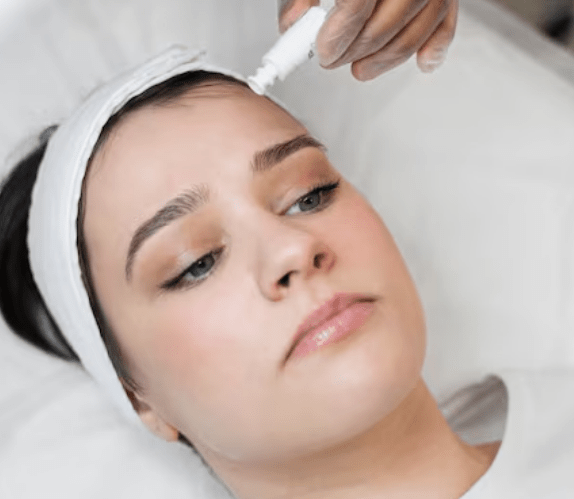Treatment Overview
The Spectra Laser (by Lutronic, Korea) is a versatile Q-Switched Nd:YAG system that operates at 1064 nm and 532 nm wavelengths. Known for its gentle yet effective energy delivery, it is one of the most widely used lasers in Korea for treating pigmented birthmarks, melasma, and post-inflammatory pigmentation (PIH).
One of its signature procedures is the Spectra Peel (Carbon Peel), but in birthmark care, it is primarily used in laser toning mode. This involves low-fluence, repetitive passes that gradually break down melanin clusters while minimizing the risk of PIH — a crucial factor for Asian skin types. It is especially effective for café-au-lait spots, Ota nevus, and epidermal pigmented lesions.
It belongs to the Birthmark & Pigmentation Treatment family (Spectra, Q-Switched Nd:YAG, Alexandrite, Ruby, Pico, CO₂ Fractional, IPL):
- Spectra (Nd:YAG Q-Switched): Best for pigmented birthmarks + PIH.
- Nd:YAG (Q-Switched, 1064/532 nm): Best for Ota nevus + dermal pigmentation.
- Alexandrite (755 nm): Best for congenital café-au-lait spots.
- Ruby (694 nm): Best for resistant pigmentation.
- Pico Lasers: Best for stubborn congenital pigment + scars.
- CO₂ Fractional: Best for superficial pigment + textural lesions.
- IPL: Best for vascular + mild pigmentation.
Purpose & Benefits
- Birthmark Clearance: Lightens congenital pigmented birthmarks (Ota nevus, café-au-lait).
- Safe Pigment Reduction: Gradually breaks down melanin clusters with low risk of rebound.
- Multi-Layer Targeting: 1064 nm for dermal pigment, 532 nm for superficial lesions.
- PIH Management: Especially effective in controlling inflammation-related pigment.
- Skin Brightening: Improves tone and restores glow.
- Acne Pigmentation Relief: Reduces post-acne dark marks often mistaken for birthmarks.
Ideal Candidates
Spectra Laser in Korea is recommended for:
- Patients with café-au-lait spots, Ota nevus, or epidermal pigmented birthmarks.
- Adults with PIH or melasma-like pigmentation.
- Individuals with sensitive skin prone to rebound pigmentation.
- Men and women comparing treatments:
- Spectra: Best for pigmented birthmarks + melasma + PIH.
- Nd:YAG: Best for deep dermal pigmentation.
- Alexandrite: Best for congenital café-au-lait.
- Ruby: Best for resistant pigmentation.
- Pico Lasers: Best for stubborn congenital lesions.
- CO₂ Fractional: Best for superficial + textural lesions.
Possible Risks & Complications
Spectra is safe, but mild side effects may include:
- Redness or Warmth: Temporary, fades in hours.
- Mild Dryness or Flaking: Short-term as skin renews.
- Temporary Darkening: Pigment may darken before lightening.
- Rare Risks: PIH or hypopigmentation (rare when performed by expert Korean dermatologists).
Surgical Techniques Used
The Spectra Laser uses Q-Switched Nd:YAG laser toning technology:
- 1064 nm: Penetrates deeper for Ota nevus and dermal lesions.
- 532 nm: Treats freckles, café-au-lait spots, and superficial pigment.
- Laser Toning: Low-fluence passes gradually reduce pigment safely.
- Protocol: 5–10 sessions spaced 2–4 weeks apart; resistant congenital lesions may need more.
Recovery & Aftercare
- Immediately: Mild redness, no downtime.
- 1–2 Days: Skin feels refreshed and slightly smoother.
- 2–4 Weeks: Pigment fades progressively with each session.
Aftercare Tips:
- Use SPF 50+ sunscreen daily.
- Apply hydrating creams and serums.
- Avoid harsh exfoliants, acids, and retinoids for 5–7 days.
- Minimize sun exposure throughout the treatment plan.
Results & Longevity
- After First Session: Brighter skin and subtle pigment fading.
- Short-Term (3–5 Sessions): Visible reduction of birthmarks and spots.
- Medium-Term (5–10 Sessions): Significant clearance of congenital pigmentation.
- Long-Term: Stable results with proper sun protection; maintenance may be required for melasma-type pigment.
Treatment Process in Korea
- Consultation & Skin Analysis – Doctor assesses birthmark type, depth, and pigmentation.
- Preparation – Cleansing, optional numbing, protective eyewear.
- Spectra Session – Gentle laser toning or targeted 532/1064 nm pulses.
- Post-Care: Cooling mask, hydration boosters, or soothing ointments.
- Follow-Up: Multi-session program designed for safe gradual clearance.
Why Korea is a Top Destination
- Korea is the home of Lutronic’s Spectra system, ensuring expertise and innovation.
- Dermatologists are highly skilled in laser toning for Asian skin prone to PIH.
- Clinics often combine Spectra with Pico or Gold Toning for complex congenital marks.
- More affordable compared to Western pigment correction packages.
- Seoul is globally known for melasma and pigmentation programs using Spectra toning.
Cost Range (Detailed Breakdown)
Pricing for Spectra Laser in Korea:
- Single Session (small birthmark area): USD 150 – 300
- Medium to Large Birthmark (per session): USD 300 – 600
- 5–10 Session Package: USD 1,200 – 3,000
Additional Costs in Korea:
- Consultation: USD 20 – 50
- Add-ons (Exosomes, PN boosters, whitening infusions): USD 100 – 400
💡 The Spectra Laser is often called “the melasma and birthmark toning laser” in Korea, thanks to its ability to lighten congenital pigmented marks safely while also controlling PIH and melasma.
Popular Clinics
- Banobagi Dermatology (Seoul): Spectra toning for café-au-lait + melasma.
- Oracle Dermatology (Seoul): Spectra protocols for Ota nevus + freckles.
- Renewme Skin Clinic (Seoul): Spectra + boosters for resistant pigmentation.
- View Plastic & Dermatology (Seoul): Spectra toning for congenital lesions.
- Chaum Anti-Aging Center (Seoul): Premium Spectra packages with regenerative add-ons.




